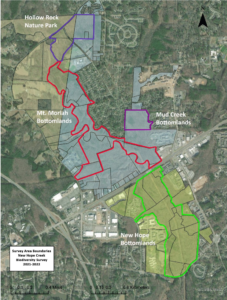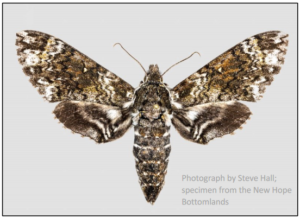Author: Stephen Brooks
In the 1980s the New Hope Floodplain and adjoining areas were identified as priorities for conservation. From 2021 to 2022, NC Biodiversity Project (NCBP) conducted a multi-taxa survey of the same area, which stretches north and west to Hollow Rock Nature Park and Mt. Moriah Bottomlands, east to Mud Creek Bottomlands, and southeast to New Hope Bottomlands. The survey’s objective was to assess the current biodiversity status of this area and identify measures necessary “to preserve the integrity of the ecosystem.” NCBP published its results at the end of 2022.
Survey Findings
While the survey includes everything from ungulates to rodents, trees, slime molds, and salamanders, noteworthy to birders is the absence of about 10 bird species that were expected to breed in the New Hope Floodplain. Especially the neotropical migrants Wood Thrush, Common Yellowthroat, Ovenbird, Hooded Warbler, and Kentucky Warbler are conspicuous in their absence.
What’s Driving Away Birds?
The report hypothesizes that a steep decline in moth populations and, more to the point, their larvae, has caused some migratory birds to stop using the survey area as a breeding site.
The report says, “macro-moths, with their larger caterpillars, are particularly important food items for birds,” (p. 82) and “the samples of macro-moths taken in the New Hope study site are conspicuously lower in both abundance and diversity than observed” at comparable sites. (p. 86) “The most obvious difference that sets the New Hope Bottomlands apart … is its closeness to urban development.” (p. 94)
Conservation Recommendations: How To Reverse the Trajectory of Bird Decline
To preserve the populations of macro-moths and breeding migratory birds in the New Hope Floodplain, conservation recommendations include efforts to:
- Reduce the impacts of artificial lights, which disorient both birds and moths
- Reducing unnecessary pesticides, especially neonicotinoids, which poison nectar-feeding insects
- Limiting the height of nearby buildings and using bird-safe windows, to reduce the frequency of fatal bird collisions; and plant native species, which provide food and habitat for native birds and insects.
The survey was a joint effort between the NC Biodiversity Project and the Durham County Open Space Program, funded through a grant from Burt’s Bees. The full 185-page report can be read here: https://nc-biodiversity.com/publication/new-hope-biodiversity-survey.
Learn More About NHAS’s Conservation Efforts Here
« Back to All Press

